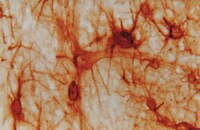A family of activity-dependent neuronal cell-surface chondroitin sulfate proteoglycans in cat visual cortex.
Lander, C, et al.
J. Neurosci., 17: 1928-39 (1997)
1997
Mostrar resumen
Monoclonal antibody Cat-301 recognizes a chondroitin sulfate proteoglycan (CSPG) expressed on the extracellular surface of cell bodies and proximal dendrites of specific subsets of neurons in many areas of the mammalian CNS, including the cat visual cortex. The Cat-301 CSPG is first detected at the close of the critical period in development, a period during which the pattern of neuronal activity determines the mature synaptic circuitry and neuronal phenotype. In the cat visual cortex, dark-rearing from birth prolongs the duration of the critical period and attenuates the expression of the Cat-301 antigen, implicating the Cat-301 CSPG in the cellular mechanisms that terminate the period of synaptic plasticity. Because the Cat-301 antigen is expressed on only a limited subset of neurons, we have further examined the molecular heterogeneity among neuronal cell-surface CSPGs and have asked (1) whether other neuronal subsets carry distinct CSPGs and (2) whether the activity-dependent expression of the Cat-301 CSPG is a property generalizable to related cell-surface CSPGs. Here, we report two new monoclonal antibodies, Cat-315 and Cat-316, which together with Cat-301 define a family of at least seven related yet distinct CSPGs. These three antibodies define nonidentical subsets of neurons in the cat visual cortex. The expression of normal levels of these CSPGs is reduced by dark-rearing. Together, these data show that the family of cell-surface CSPGs is molecularly diverse, that different sets of neurons express distinct complements of cell-surface antigens, and that the regulation of CSPG expression by activity may be a general feature of neuronal cell-surface CSPGs. | 9045722
 |










